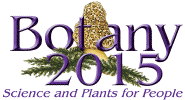| Abstract Detail
Paleobotanical Section Gandolfo, Maria A. [1], Zamaloa, Maria C. [2], Archangelsky, Ana [3], Archangelsky, Sergio [3], Barreda, Viviana [3], Cuneo, N. Ruben [4], Hermsen, Elizabeth [5], Iglesias, Ari [6], Llorens, Magdalena [7], Narvaez, Paula [8], Passalia, Mauro [9], Perez Lonaize, Valeria [3], Povilauskas, Leticia [10], Pramparo, Mercedes B. [11], Puebla, Griselda [11], Quattrocchio, Mirta [12], Romero, Edgardo J. [3], Vallati, Patricia [13], Wilf, Peter [14]. An Updated Comprehensive Study Of Cretaceous-Paleogene Angiosperms From Argentina. Today, the angiosperms constitute the largest clade of seed plants with more than 300,000 species distributed worldwide. They are found on every continent including Antarctica, in all types of terrestrial environments, and even in marine habitats. During the last decade, and with the advent of newer molecular sequencing techniques, major advances have made in elucidating the origin and evolution of the angiosperms; however, many aspects of their evolutionary history still remain enigmatic. Paleobotanists have long recognized that the plant fossil record provides the only tangible evidence of the occurrence of angiosperms through time and contributes fundamental information that enlightens our understanding of their origin, life habits, history, radiation, and diversification. The majority of data on fossil angiosperms comes from the Northern Hemisphere because it has been intensively studied; the Southern Hemisphere’s paleofloras, in contrast, have been understudied and are relatively poorly understood. Sedimentary rocks from Argentina, in southern South America, offer a wealth of angiosperm floras that provide critical data for addressing some of those questions. We are undertaking a comprehensive review of the micro- and macrofossil record of the angiosperms that inhabited Argentina from their first appearance during the late Barremian (earliest Early Cretaceous) to the Cretaceous-Paleogene (Maastrichtian-Danian) boundary, with the intent of understanding: 1-what taxonomic groups were present at what times and 2) the development of plant communities through time based on their constituent taxa. Data were gathered from 24 formations within six basins in Salta, Mendoza, and San Luis provinces, as well as in Patagonia. Results indicate that members of the basal angiosperms, Chloranthales, and monocots were already present during the Aptian-Albian in Argentina, and Clavatipollenites was represented by several species during the early Aptian; in the Cenomanian to the Campanian, the monocots, the eudicots (including members of the core eudicots) and the rosids (rosid I and II) became more diverse and similar to extant genera; and in the Paleocene, the asterids were members of the paleocommunities. Peninsullapolis gilli represents the oldest record of Proteaceae for Argentina and occurs in all the upper Campanian to Maastrichtian. Based on this review, it is evident that macrofossils are still poorly collected.
Log in to add this item to your schedule
1 - Cornell University, L.H. Bailey Hortorium, Plant Biology Section, 410 Mann Library Building, SIPS, Ithaca, NY, 14853, United States
2 - Universidad de Buenos Aires, Departamento de Ecología, Genética y Evolución, Facultad de Ciencias Exactas y Naturales, Intendente Güiraldes 2620, Buenos Aires, C1428EHA, Argentina
3 - Museo Argentino de Ciencias Naturales Bernardino Rivadavia, Av. Angel Gallardo 470, Buenos Aires, C1405DJR , Argentina
4 - Mef Av. Fontana 140, Trelew-Chubut, N/A, 9100, Argentina
5 - Ohio University, Department of Environmental and Plant Biology, Athens, OH, 45701, USA
6 - Universidad Nacional del Comahue-CONICET, Instituto de Investigaciones en Biodiversidad y Medioambiente, Quintral 1250, San Carlos de Bariloche, Rio Negro, C8400, Argentina
7 - Comisión Nacional de Energía Atómica-Regional Patagonia, 26 de Noviembre s/n, Trelew, Chubut, C9100, Argentina
8 - Instituto Argentino de Nivología, Glaciología y Ciencias Ambientales, Centro Regional de Investigaciones Científicas y Tecnológicas, Adrián Ruiz Leal s/n, Mendoza, Mendoza, C5500, Argentina
9 - Universidad Nacional del Comahue-CONICET, Quintral 1250, San Carlos de Bariloche, Rio Negro, C8400, Argentina
10 - Universidad Nacional de La Plata, División Paleobotánica, Facultad de Ciencias Naturales y Museo, Paseo del Bosque s/n, La Plata, Buenos Aires, C1900, Argentina
11 - Instituto Argentino de Nivología, Glaciología y Ciencias Ambientales, Adrián Ruiz Leal s/n, Mendoza, Mendoza, C5500, Argentina
12 - Universidad Nacional del Sur, INGEOSUR- Departamento de Geología, San Juan 670, Bahia Blanca, Buenos Aires, C8000, Argentina
13 - Universidad Nacional de la Patagonia San Juan Bosco, Departamento de Geología, Facultad de Ciencias Naturales, Ruta Prov. No 1 S/N km 4, Comodoro Rivadavia, Chubut, C9000, Argentina
14 - Penn State Univ., 537 Deike Bldg., University Park, PA, 16802, USA
Keywords:
angiosperms
fossils
Cretaceous
Paleogene
Argentina.
Presentation Type: Oral Paper:Papers for Sections
Session: 28
Location: Salon 13/The Shaw Conference Centre
Date: Tuesday, July 28th, 2015
Time: 8:15 AM
Number: 28002
Abstract ID:720
Candidate for Awards:None |

